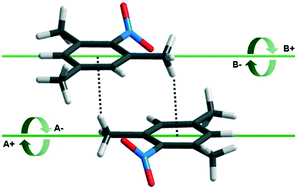Ferroelectricity and switching polarization on the C–H⋯π bond in a pure organic molecular crystal – 1,3,5-trimethylnitrobenzene†
Abstract
The novel single component molecular ferroelectric single crystal of 1,3,5-trimethylnitrobenzene (TMNB) has been investigated in terms of its temperature dependent polar properties. Three phases have been found in the solid state of TMNB: phase I above 161 K, phase II (incommensurate) between 161 and 152 K and phase III below 152 K. The TMNB crystal structures were determined at 100 K (phase III, sp. gr. Pca21) and at 250 K (phase I, sp. gr. Pnma). Ferroelectricity of phase III along the c-axis has been confirmed by the pyroelectric measurements and observations of the hysteresis loops, revealing spontaneous polarization as small as ∼2 × 10−6 C m−2. The crystal is the first example of an origin of spontaneous polarization related to flexibility of the C–H⋯π hydrogen bonds (molecular joints). The TMNB molecules in the dimer can change the mutual orientation of the dipole moments without breaking the C–H⋯π bonds. In this paper, the mechanism of the phase transitions will be discussed, which is governed by the dynamics of the NO2 groups and the flexibility of the C–H⋯π dimer.

- This article is part of the themed collection: Supramolecular & Polymorphism


 Please wait while we load your content...
Please wait while we load your content...